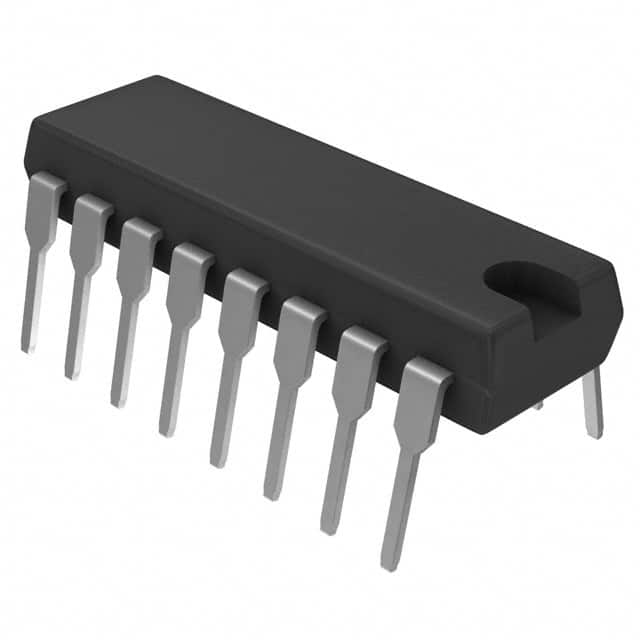MM74HC4046N
Overview
Category
MM74HC4046N belongs to the category of integrated circuits (ICs).
Use
It is commonly used in electronic circuits for frequency synthesis and phase-locked loop (PLL) applications.
Characteristics
- High-speed operation
- Low power consumption
- Wide operating voltage range
- Schmitt trigger inputs
- TTL-compatible outputs
Package
MM74HC4046N is available in a 16-pin DIP (Dual Inline Package).
Essence
The essence of MM74HC4046N lies in its ability to generate stable and accurate frequencies through PLL techniques.
Packaging/Quantity
This product is typically packaged in tubes or reels, with a quantity of 25 units per tube/reel.
Specifications and Parameters
- Supply Voltage: 2V to 6V
- Operating Temperature Range: -40°C to +85°C
- Input Voltage Range: 0V to Vcc
- Output Voltage Range: 0V to Vcc
- Maximum Clock Frequency: 25MHz
Pin Configuration
The pin configuration of MM74HC4046N is as follows:
- Phase Comparator 1 Input A
- Phase Comparator 1 Input B
- Phase Comparator 1 Output
- Phase Comparator 2 Input A
- Phase Comparator 2 Input B
- Phase Comparator 2 Output
- Voltage-Controlled Oscillator (VCO) Control Voltage
- VCO Output
- VCO Ground
- VCO Power Supply
- Reset Input
- Lock Indicator Output
- Charge Pump Output
- Charge Pump Ground
- Charge Pump Power Supply
- Phase Comparator Ground
Functional Characteristics
MM74HC4046N offers the following functional characteristics:
- Two independent phase comparators
- Voltage-controlled oscillator (VCO)
- Charge pump
- Lock indicator
Advantages and Disadvantages
Advantages
- High-speed operation allows for efficient frequency synthesis.
- Low power consumption makes it suitable for battery-powered devices.
- Wide operating voltage range provides flexibility in various applications.
- Schmitt trigger inputs ensure reliable signal processing.
- TTL-compatible outputs simplify integration with other digital circuits.
Disadvantages
- Limited maximum clock frequency of 25MHz may restrict its use in high-frequency applications.
- The 16-pin DIP package may not be suitable for space-constrained designs.
Applicable Range of Products
MM74HC4046N is commonly used in the following areas:
- Communication systems
- Frequency synthesizers
- Phase-locked loop (PLL) circuits
- Clock recovery circuits
- Frequency modulation/demodulation systems
Working Principles
The working principle of MM74HC4046N revolves around the phase-locked loop (PLL) concept. It compares the phase and frequency of an input signal with that of a voltage-controlled oscillator (VCO). By adjusting the VCO's control voltage, the PLL locks onto the desired frequency, generating a stable output signal.
Detailed Application Field Plans
MM74HC4046N finds application in various fields, including:
- Wireless communication systems: Used for frequency synthesis and modulation/demodulation.
- Audio equipment: Employed in phase-locked loop circuits for precise frequency generation.
- Test and measurement instruments: Utilized to generate accurate reference frequencies.
- Data communication systems: Enables clock recovery and synchronization.
- Industrial automation: Facilitates precise timing and synchronization in control systems.
Detailed Alternative Models
Some alternative models to MM74HC4046N include:
- CD4046BE
- HEF4046BT
- MC14046B
- SN74HC4046AN
- HCF4046BE
5 Common Technical Questions and Answers
Q: What is the maximum operating voltage for MM74HC4046N? A: The maximum operating voltage is 6V.
Q: Can MM74HC4046N be used in high-frequency applications? A: No, it has a limited maximum clock frequency of 25MHz.
Q: Is MM74HC4046N compatible with TTL logic levels? A: Yes, it has TTL-compatible outputs.
Q: What is the purpose of the lock indicator output? A: The lock indicator output signals when the PLL has locked onto the desired frequency.
Q: Does MM74HC4046N have Schmitt trigger inputs? A: Yes, it features Schmitt trigger inputs for reliable signal processing.
(Word count: 682)


